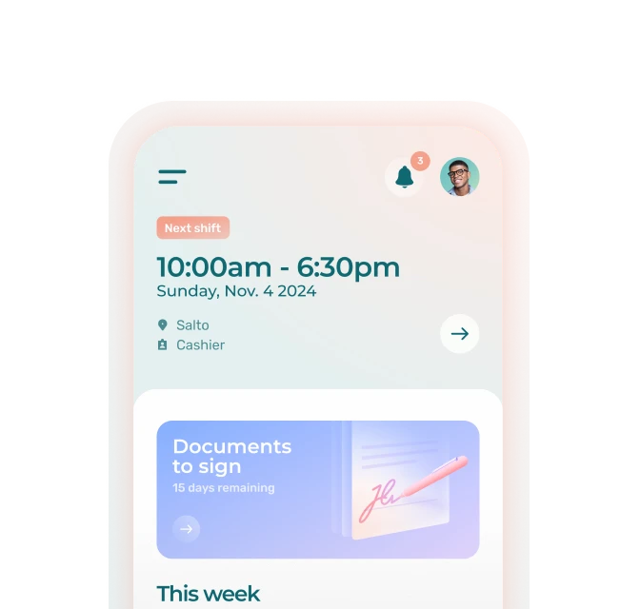Employee management and workplace discipline are part of every manager’s daily routine. When problematic behavior or poor performance emerges, it’s essential to address it in a fair and constructive way.
This is where progressive discipline becomes a key tool. It gives employees the opportunity to improve and strengthens employer-employee relations. You should adopt this approach to cultivate a healthy work environment and establish trust with your team members.
Discover how progressive discipline can not only prevent conflict, but also promote a healthier and more productive work environment.
What Is Progressive Discipline?
Progressive discipline is a management approach that involves a step-by-step process to address an employee’s behavior or actions. The severity of the consequences is proportional to the seriousness of the issue, following a graduated scale.
Progressive discipline involves creating an action plan in collaboration with the employee, providing them with the opportunity to improve their performance or change their behavior.
This method ensures fair treatment of all employees and avoids discrimination.
The different steps are carried out by managers, who are responsible for documenting all disciplinary processes within the company. In smaller organizations, it is usually the manager who oversees the implementation of these steps and maintains records of their actions.
Why Adopt Progressive Discipline?
Progressive discipline is the most commonly used form of workplace discipline, as it helps build trust-based relationships and fosters a healthy work environment.
This is also the way to avoid legal problems. Many countries require a gradual approach to disciplinary measures, so that employees have the opportunity to rectify the situation before being dismissed.
The benefits of adopting progressive discipline include:
- Encourage employees to improve
- Help avoid legal issues
- Strengthen the employer-employee relationship
- Maintain a professional and healthy work environment
- Encourage transparency and honesty
- Promote employer-employee collaboration
- Reduce employee turnover
How to Use Progressive Discipline in Your Workplace
Applying progressive discipline methods in the workplace involves adopting a structured approach to address problematic behaviors or inadequate employee performance.
The goal is to correct these problems in a fair, transparent and constructive way, while respecting the employee’s rights and the company’s needs.
To use progressive discipline in your organization, you need a clear disciplinary policy that includes :
- Corporate rules and expectations
- Behaviors or infractions that may give rise to disciplinary measures
- Progressive steps
- Deadlines and criteria for moving from one stage to the next
Typical Stages of Progressive Discipline
The steps of progressive discipline are :
1. Verbal warning : an informal conversation with your employee in which you explain the problem. Even though it’s informal, you need to keep a written record of this interaction.
2. Written warning : an official document containing the details of the problem, your expectations and the consequences if the situation does not change. This document must be signed and dated by the employee.
Here’s a guide to everything you need to know about warning at work.
3. Mandatory training : you can require your employee to attend training to upgrade their skills and help improve their performance.
4. Temporary suspension (with or without salary) : the terms of the suspension should be outlined in an official letter given to the employee and signed by them.
5. Downgrading : retrograde an employee is sometimes necessary, but this disciplinary action should not be taken lightly, as it can significantly demotivate the affected employee.
6. Dismissal : this is the final and definitive step that ends the employment contract with the employee. Dismissal should only be used as a last resort after multiple interventions by the employer. The only time termination is the first and last step is when an employee commits a serious offense.
Read our dismissal bible.
Before taking disciplinary action, it’s important to ask employees questions, understand the situation and have all the relevant information on hand to properly assess the problem.
What You Need to Do Before Taking Disciplinary Action
Here are the steps to follow before taking disciplinary action
- Meet the employees involved.
- Document your approach: date, time, people involved, context, etc.
- Measure the seriousness of the situation: impact on the team, the company or safety.
- Validate facts.
Once the disciplinary action is initiated, each step must be documented by the HR manager or supervisor. This is a legal matter in case the employee challenges the measures taken.
To keep track of what you’ve done, record your notes in your employee files. Agendrix employee management software lets you digitize this information, centralizing it and securing it at the same time. This way, you can quickly access the data and never risk losing it.
What to Include in HR Policies
Progressive discipline is only possible if the organization has clear and transparent internal policies in place. It is challenging for an employer to address behaviors or actions that have never been identified as unacceptable or inadequate.
Set clear expectations so that your employees know what rules to follow. Make sure your policies are easily accessible so that employees can refer to them. Always take the time to answer any questions they may have.
Internal policies also help protect the company in the event of a dispute between employer and employee.
Examples of Progressive Disciplinary Measures
1. Lateness
An employee at a pharmacy arrives 20 minutes late for their shift. They did not call ahead to inform you and did not apologize upon arriving at the store and crossing paths with you.
You decide to meet with them to understand what happened. The employee explains that they were delayed due to traffic. You remind them that in the future, it is important to leave earlier to account for potential delays and to call if they anticipate being more than five minutes late.
If the situation happens again, you will have to issue an official written warning. The employee acknowledges this and assures you they will be more mindful going forward.
One week later, the employee arrives 30 minutes late. Once again, they do not call ahead and cite traffic as the reason. As a result, you decide to issue the written warning.
A few weeks later, you notice the employee’s punctuality has improved. You take a moment to acknowledge this and congratulate them on their diligence.
2. Insubordination
A waiter refuses to wear the uniform required for his job and to execute some of his assigned tasks (for example, cleaning tables after his service).
You arrange a private discussion with the employee. You explain why it’s important to adhere to the dress code and complete the tasks assigned to him. The employee seems to understand the importance of his responsibilities and commits to following the dress code in the future.
Despite the verbal warning, the employee again refuses to clean the tables the next day. You then issue a formal written warning. This document describes the specific problematic behavior, reiterates expectations and specifies consequences if the problem persists.
The employee still refuses to follow your instructions and adopts a defiant attitude, openly challenging the orders in front of customers.
You decide to suspend the employee for 2 days without pay. This suspension is a result of their repeated acts of insubordination. Upon their return, the employee still maintains the same attitude and once again refuses to comply with the rules.
The employee is scheduled for a final meeting. After a discussion in which the previous steps are reviewed, the employee is handed a letter of dismissal, terminating his contract for repeated insubordination.
3. Theft of Time
A cashier at a grocery store frequently leaves his post without authorization, stays on his phone and repeatedly exceeds the authorized duration of his breaks.
You notice that the employee has been on break for 20 minutes, while breaks are only supposed to last 10 minutes. You decide to meet with them and explain that their unauthorized extended breaks disrupt the workflow and prevent their colleagues from taking their breaks.
The employee apologizes for their behavior. You explain that the next step will be a written warning and that after 3 formal warnings, they will be terminated.
A few weeks later, you notice that your employee continues to take extended breaks, but registers his hours as if he had only taken 10 minutes. You examine the surveillance cameras and discover that the employee clocks in and then returns to sit in the break room.
You meet with the employee to give him a formal written warning and explain the seriousness of the situation. You also explain that you will continue to monitor the employee’s break times, to make sure he respects the time limit.
The employee rectifies his behavior and respects the break time set out in the company’s internal policy.
💡 When interacting with your employees, be direct and respectful. Give your employees the opportunity to explain and share their difficulties. Finally, offer your support and suggest solutions.
In Summary
- Verify the facts before imposing a sanction on an employee
- Be fair and equitable
- Be proactive
- Document your disciplinary actions
- Clearly explain the problem to your employees
- Work with your team members to find solutions
- Adjust your disciplinary measures to fit each situation
- Clearly communicate your expectations
- Give your employees a chance to improve
- Follow up regularly
Is It Possible to Impose a Disciplinary Measure for Misconduct that Occurred Outside of Work?
It is possible to impose a disciplinary measure on an employee for misconduct that occurred outside of the workplace if it harms the employer.
For example, if an employee films and posts a video of themselves making racist and discriminatory comments while wearing their work uniform, the employer could decide to terminate their employment contract.
It is important to refer to the laws and regulations in your region. Don’t hesitate to consult a labor law professional if you have any doubts.
How Long Must Disciplinary Measures Last?
The length of disciplinary measures varies according to the company’s internal policies and the seriousness of the misconduct.
For example, a company may decide that a written warning is valid for 3 months. After this period, the warning is removed from the employee’s file. The duration of a suspension (with or without pay) can also vary depending on the situation, ranging from a few days to several months.
Each situation is unique and may require slightly different measures.
Can a Disciplinary Measure Be Imposed Twice for the Same Misconduct?
The same disciplinary measure can be imposed multiple times for the same misconduct, depending on the context and if the company’s internal policy allows it.
In a progressive discipline system, disciplinary actions become more severe if the misconduct persists. However, a specific measure (such as a written warning) can be repeated if:
- The time lapse between misbehaviors is significant, for example several months
- You feel that the situation has not reached a level requiring more severe action
- Internal company policy specifies that disciplinary action may be taken more than once
However, it’s important that you don’t repeat the same measure indefinitely, otherwise the effectiveness and relevance of the disciplinary measure will be compromised.
What Is Serious Misconduct?
Serious misconduct refers to an offence or behavior on the part of the employee that is so serious as to justify immediate termination of the employment contract, without notice or severance pay.
For example, theft or failure to respect the confidentiality of company data may be considered serious misconduct.
Characteristics of serious misconduct include :
- The seriousness of the behaviour
- Impact on the organization
- Impossibility of maintaining the employment contract










